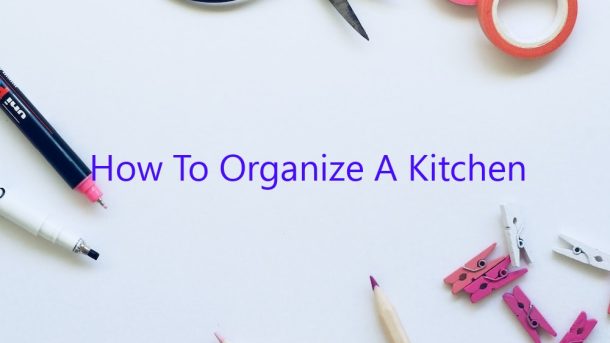One of the busiest places in the home, the kitchen can quickly become cluttered and chaotic. However, with a little bit of organization, it can be easy to keep this space tidy and functional.
The first step in organizing a kitchen is to declutter. Get rid of any items that you don’t use on a regular basis, or that are taking up unnecessary space. Once you’ve decluttered, you can begin to organize the space according to your needs.
One of the most important things to consider when organizing a kitchen is the layout. Make sure that the areas you use most often are within easy reach. If you have a lot of counter space, consider using it to store kitchen appliances and tools that you use regularly. You can also use hooks and racks to organize spices, pots and pans, and other cooking supplies.
If you have a lot of cabinets and drawers, consider using drawer dividers and cabinet organizers to keep everything neatly organized. You can also use labels to identify each drawer and cabinet. This will make it easy to find what you need when you need it.
Finally, be sure to clean your kitchen regularly. This will help to keep it organized and functional.
Contents
- 1 How should I arrange my kitchen?
- 2 How do you decide where to put things in kitchen cabinets?
- 3 What are 10 tips for having a well organized kitchen?
- 4 What are the 10 steps in organizing kitchen cabinets?
- 5 Where should pots and pans be placed in kitchen?
- 6 How do you group things in a kitchen?
- 7 Where do plates and glasses go in the kitchen?
How should I arrange my kitchen?
When it comes to arranging your kitchen, there are a few things to consider. How much space do you have? What type of kitchen layout do you prefer? What are your must-have appliances and storage spaces?
Once you’ve answered these questions, you can start to figure out how to best arrange your kitchen. If you’re short on space, consider using cabinets and shelves to maximise storage. If you have a large kitchen, you may want to consider creating separate areas for cooking, eating and storage.
No matter what layout you choose, be sure to make use of every inch of space. Place frequently used appliances and tools within easy reach, and think about ways to maximise storage space. Adding shelves, drawers and cabinets can help you make the most of your kitchen.
When it comes to decorating your kitchen, there are no set rules. However, it’s important to use colours and materials that are both durable and easy to clean. You may also want to consider using a backsplash to protect your walls from spills and splatters.
Ultimately, the best way to arrange your kitchen is the way that works best for you. Experiment with different layouts and see what works best for your needs. With a little bit of planning, you can create a kitchen that’s both functional and stylish.
How do you decide where to put things in kitchen cabinets?
When it comes to kitchen cabinets, organization is key. But it can be tough to know where to start, especially if your cabinets are already full. Here are a few tips on how to organize your kitchen cabinets so everything has its own place.
First, think about what you use most often. This should be your top priority when organizing your cabinets. Whatever you use most often should be within easy reach.
If you have a lot of small items, like spices or utensils, consider using a drawer or cabinet organizer to keep everything organized. This will make it easier to find what you need when you need it.
Another thing to consider is how you use your cabinets. If you mainly use the top cabinets for dishes and glasses, put those items on the top shelves. If you use the bottom cabinets for pots and pans, put those items on the bottom shelves.
And finally, think about how much space you have. If you have a lot of space in your cabinets, you can be more flexible with how you organize them. But if you’re limited on space, you’ll need to be more specific with where you put things.
With these tips in mind, you can create a cabinet organization system that works for you.
What are 10 tips for having a well organized kitchen?
A kitchen is arguably one of the most important rooms in a home. Not only is it where meals are prepared and eaten, but it’s also a gathering place for family and friends. With all the activity that takes place in a kitchen, it’s important to have it organized to make things run smoothly. Here are ten tips for having a well organized kitchen.
1. Declutter your kitchen. The first step in organizing your kitchen is to declutter it. Get rid of any unnecessary items that are taking up space and make it difficult to work.
2. Create zones in your kitchen. A good way to organize your kitchen is to create zones for different activities. This might include a cooking zone, a baking zone, a dishwashing zone, and a storage zone.
3. Use drawer dividers and cabinet organizers. Maximize the space in your cabinets and drawers by using dividers and organizers. This will help you to organize your kitchen utensils, pots and pans, and spices.
4. Install a pegboard. A pegboard is a great way to organize your kitchen tools. You can hang pots and pans, utensils, and other kitchen gadgets on the pegboard.
5. Use a label maker. Labeling your kitchen storage containers will help you to quickly find what you need. It will also help to keep the kitchen organized.
6. Store food in airtight containers. Storing food in airtight containers will help to keep it fresh and prevent it from spoiling.
7. Use a designated storage area for recycling. A great way to keep your kitchen organized is to have a designated storage area for recycling. This will make it easy to recycle cans, bottles, and other recyclable items.
8. Use a trash can with a lid. A trash can with a lid will help to keep your kitchen clean and organized.
9. Install a dish drying rack. A dish drying rack will help to keep your kitchen counters clean and organized.
10. Keep a kitchen calendar. A kitchen calendar is a great way to keep track of what’s happening in the kitchen. You can use it to write down recipes, to-do lists, and grocery lists.
What are the 10 steps in organizing kitchen cabinets?
If you’ve ever felt like your kitchen cabinets are a cluttered and chaotic mess, you’re not alone. In fact, many people find themselves struggling to keep their kitchen cabinets organized and tidy.
Fortunately, there are some simple steps you can take to organize your kitchen cabinets in just 10 easy steps. So, if you’re looking for a way to get your cabinets under control, keep reading.
1. Empty your cabinets completely.
The first step in organizing your kitchen cabinets is to empty them completely. This will allow you to see everything that’s in your cabinets and determine what needs to be sorted and organized.
2. Sort through your items.
Once your cabinets are emptied, it’s time to sort through the items. This can be done by category (e.g. dishes, pots and pans, utensils, etc.) or by function (e.g. baking supplies, cooking supplies, etc.).
3. Group like items together.
Once you’ve sorted through your items, it’s time to group like items together. This will help keep your cabinets organized and tidy.
4. Create designated spaces for each group of items.
Once you’ve grouped your items together, it’s important to create designated spaces for each group. This will help you easily find and access the items you need.
5. Label each space.
Once you’ve created designated spaces for each group of items, be sure to label each space. This will help you remember where each item belongs and make it easier to put things back in their proper place.
6. Install drawer dividers (if needed).
If you have a lot of items that need to be sorted into categories, like pots and pans, you may need to install drawer dividers. This will create separate spaces for each category and make it easier to organize your kitchen cabinets.
7. Organize your pots and pans.
If you’re struggling to organize your pots and pans, there are a few tips you can follow. First, try sorting them by size. Then, create designated spaces for each type of pot or pan. Finally, label each space so you know where everything goes.
8. Organize your dishes.
If you’re struggling to organize your dishes, there are a few tips you can follow. First, try sorting them by type. Then, create designated spaces for each type of dish. Finally, label each space so you know where everything goes.
9. Organize your utensils.
If you’re struggling to organize your utensils, there are a few tips you can follow. First, try sorting them by type. Then, create designated spaces for each type of utensil. Finally, label each space so you know where everything goes.
10. Put everything back in its place.
Once you’ve sorted and organized your kitchen cabinets, it’s time to put everything back in its place. This may take a little time, but it’s worth it in the end.
Follow these 10 steps and you’ll be able to organize your kitchen cabinets in no time.
Where should pots and pans be placed in kitchen?
There are many schools of thought on where pots and pans should be placed in the kitchen. Some people prefer to have them all in one place, while others like to have them spread out so they can be accessed more easily. Here are a few ideas on where to put your pots and pans in the kitchen:
1. In a pot rack. This is a great option if you have a lot of pots and pans and limited storage space. A pot rack can be mounted on the wall or hung from the ceiling.
2. In a cabinet. If you have a cabinet that’s specifically designated for pots and pans, this is a great place to put them.
3. On a shelf. If you don’t have a pot rack or cabinet, you can put your pots and pans on a shelf. Just make sure there’s enough room to access them easily.
4. In a drawer. If you have a drawer that’s specifically designated for pots and pans, this is a great place to put them.
5. In a cart. If you don’t have a lot of cabinet or drawer space, you can put your pots and pans on a cart. This is a great option if you like to keep your pots and pans handy.
No matter where you decide to put your pots and pans, just make sure they’re easy to access. You don’t want to have to go through a lot of trouble to get to them when you’re cooking dinner.
How do you group things in a kitchen?
A kitchen is a room in a house where food is prepared. Kitchens can be large or small, but they all have some basic features in common. One of the most important things to consider when organizing a kitchen is how to group things.
There are a few basic ways to group things in a kitchen. One way is to group them by function. This means grouping together all of the things that you use for a specific task. For example, you might put all of your pots and pans together, all of your knives together, or all of your spices together.
Another way to group things is by type. This means grouping together all of the items of the same type. For example, you might group all of your plates together, all of your cups together, or all of your bowls together.
A third way to group things is by location. This means grouping together all of the items that are used in the same area of the kitchen. For example, you might group all of your baking supplies together, all of your utensils together, or all of your food storage together.
Grouping things by function, type, or location can be a great way to organize a kitchen. However, it is important to tailor the organization to fit your specific needs. There is no one perfect way to organize a kitchen, so experiment until you find a system that works for you.
Where do plates and glasses go in the kitchen?
When it comes to dish placement in the kitchen, there are a few things you should know. Generally, plates and glasses go on the countertop, while pots, pans, and other cooking utensils go in the cabinets. However, there are a few exceptions to this rule.
If you have a lot of counter space, you can place plates and glasses on the counter. This will make it easy to grab them when you’re ready to eat. However, if you have a lot of dishes, you may want to put them in the cabinets to save space.
If you have a small kitchen, you may want to put plates and glasses in the cabinets to free up counter space. Pots and pans can go on the stovetop or in the oven, depending on what you’re cooking.
No matter where you put your dishes, make sure to clean them up after you’re done using them. This will help keep your kitchen clean and organized.




